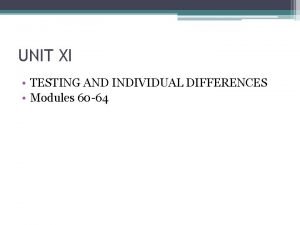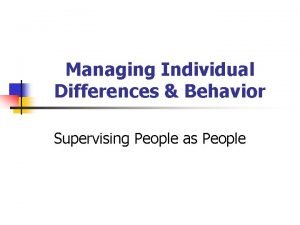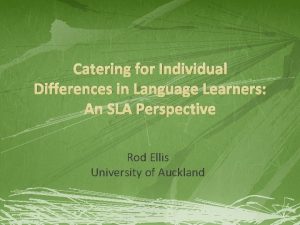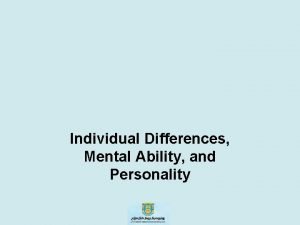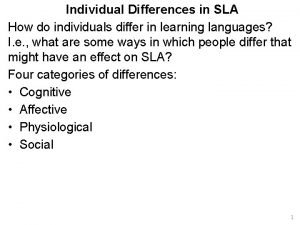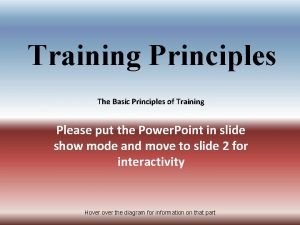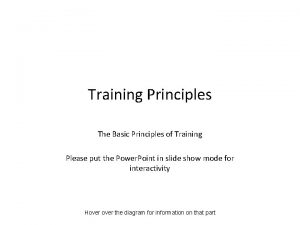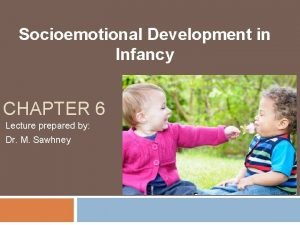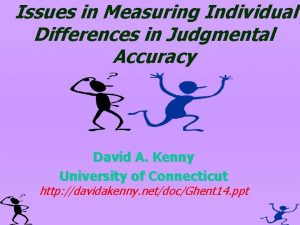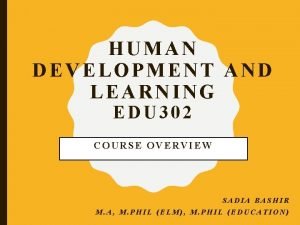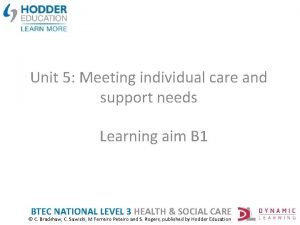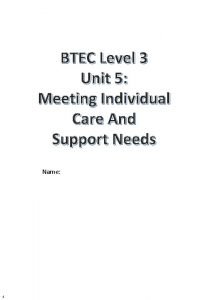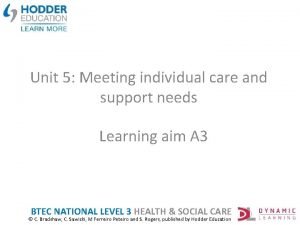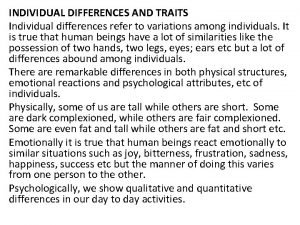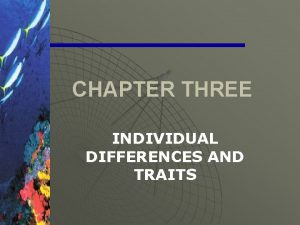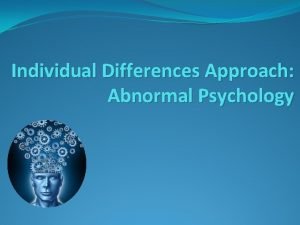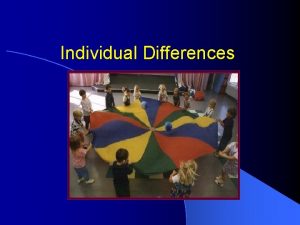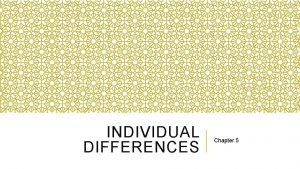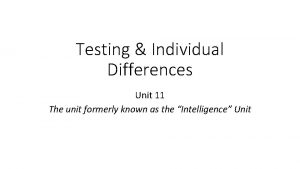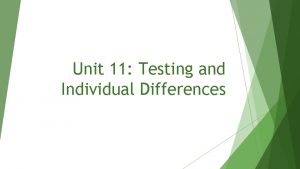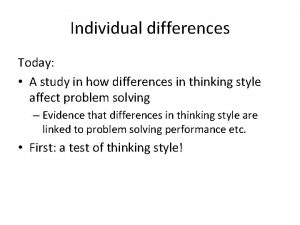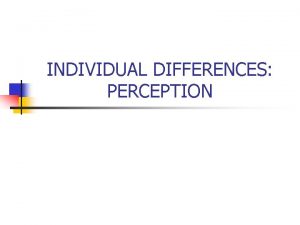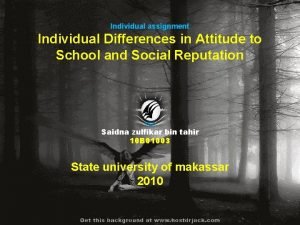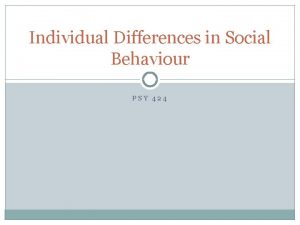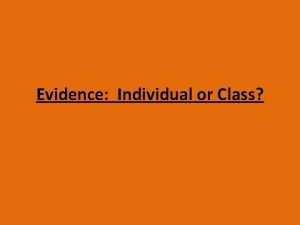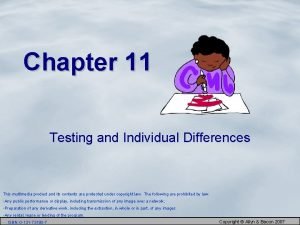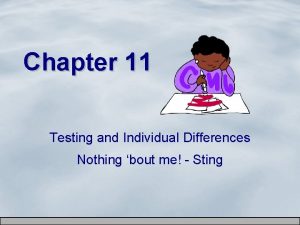UNIT 11 Testing and Individual Differences THIS IS
























- Slides: 24


UNIT 11: Testing and Individual Differences

THIS IS A TEST!! Write these words and their definitions You have 10 minutes…GO Intelligence Savant syndrome Emotional intelligence Reliability Validity

The Real Rain Man

INTELLIGENCE The ability to acquire new ideas and new behavior, and to adapt to new situations. Different views on Intelligence exist One general intelligence (g): Charles Spearman; people have special abilities that stand out. Common skill set (g) underlies all intelligent behavior. Gardner’s Multiple Intelligence Theory: Howard Gardner; Numerous (8) and unrelated intelligences. Emotional Intelligence: The ability to perceive, use, understand, and regulate emotions.


INTELLIGENCE TEST Measure IQ, or a standardized measure of intelligence based on a scale of which 100 is average Stanford-Binet Intelligence Scale: • Originally meant for children; adapted for adults • Groups test items by age level • 100 is average for given age Wechsler Tests: • More common today • Three versions (2 -6, 6 -16, 16 -89) • More detailed scoring

IQ SCORES – What do they mean? Average score is 100 Traditionally 70 or below = mentally handicapped Good indicator of success in school Do not predict success in the real world Nature v. Nurture: Both genetic factors & the environment play a role in IQ. The % each contributes is debatable. Cultural Bias: wording used in questions may be more familiar to people or one social group than to another group

Sternberg’s Three Intelligences


Brain Function Perceptual Speed: Neurological Speed: +. 3 to +. 5 correlation -taking in perceptual information Highly intelligent people register stimuli quicker and with greater complexity

Test Construction Standardization Normal curve Reliability Validity

Extremes of Intelligence Intellectual Disability

Extremes Sho Yano has an IQ over 200. Age 4: composing music Age 7: high school Age 8: Scored a 1, 500 on the SAT Age 9: Started college at age 9 Age 12: Began medical school Age 18: Awarded MD and Ph. D Now Pediatric Neurologist

“How–To” Presentations Rubric: 100 points total 10 pts … Has a recognizable theme 10 pts… Includes detailed steps 10 pts… Grammatically correct & legible 15 pts… Creativity 15 pts… Summary of your how-to including how it relates to the intelligence you used (1 page). 20 pts… Includes original supplemental material (book/skit/worksheet/song, etc. ) 20 pts… Group members contributed

Origins of Intelligence Testing Societies: 1. promote collective welfare 2. emphasize individual opportunity Western cultures: heir’s to Plato’s individualism, want to assess differences Francis Galton (Darwin’s cousin) created first “natural ability” test. Ultimately not reliable or valid. But did give us phrase “nature v. nurture”

Alfred Binet Early twentieth century, France passed aw requiring school for all children. Binet and Theodore Simon began measuring “mental age”. Theorized mental aptitude is a general trait that shows up in various ways. Made no assumptions about why a child was slow, average, or gifted. Feared it would be used to label children.

Lewis Terman Stanford University professor Adapted Binet’s tests to U. S. children Became Stanford-Binet test IQ= (mental age divided by chronological age) multiplied by 100

Modern Tests Achievement tests: reflect what you’ve learned Aptitude tests: predict your ability to learn Both tests influence each other David Weschler created Weschler Adult Intelligence Scale (WAIS) with a version for school-aged children Weschler test is most widely used today

Dynamics of Intelligence By age 4 IQ tests predict adolescent and adult scores By age 7 the scores stabilize Ian Deary: long term follow up study June 1, 1932 nearly every child in Scotland between 10. 511. 5 was tested 65 years later all survivors (542) were retested Scores were strikingly similar High scoring children were more likely to be living independently and less likely to suffer late-onset Alzheimer’s as 77 year olds. 70% of highest scoring females were still living (WWII ended more male lives prematurely)

Genetics and Environment Genetics Intelligence runs in families Intelligence scores of identical twins raised together are extremely similar Researchers have identified chromosomal regions that influence intelligence and learning disabilities Environment Studies show adoption enhances intelligence scores of mistreated or neglected children Fraternal twins score more alike than other siblings because they are treated more alike Mental similarities decrease with age Genetic influences become more apparent as we accumulate life experience

Early Environment Influences Genes make a difference: IF TWO PEOPLE ARE RAISED IN THE SAME ENVIRONMENT THEY WILL HAVE DIFFERING APTITUDES However, poor environmental conditions can override genetics Mc. Vicker Hunt observed destitute Iranian orphanage: Average child couldn’t sit up at age 2 or walk at age 4 Extreme deprivation inhibits intelligence

Differences in Testing Gender: Females: score higher at spelling, verbal ability, nonverbal memory, sensation, emotion-detecting ability Males: score higher at math and spatial aptitudes Culture: Racial groups differ in average scores Differences within countries: Israeli Jews outscore Israeli Arabs and hearing people outscore deaf people High-scoring in all groups are more likely to achieve higher education levels and income

Bias Debate over race differences are divided into three thoughts: There are genetically disposed race differences in intelligence There are socially influenced race differences in intelligence There are race differences in test scores, but the tests are inappropriate or biased Two meanings of bias If it detects not only innate differences in intelligence but also performance differences caused by cultural experiences Scientific meaning- hinges on test’s validity; whether it predicts future behavior for only some groups of testtakers
 Unit xi testing and individual differences
Unit xi testing and individual differences Managing individual differences and behavior
Managing individual differences and behavior Proactive personality
Proactive personality Functional testing vs unit testing
Functional testing vs unit testing Individual differences factors
Individual differences factors Catering to individual differences
Catering to individual differences Perbedaan individu dalam organisasi
Perbedaan individu dalam organisasi Pengertian perilaku organisasi
Pengertian perilaku organisasi Individual differences factors
Individual differences factors Individual differences in sla
Individual differences in sla Principles of training individual differences
Principles of training individual differences Principles of training individual differences
Principles of training individual differences Thomas and chess temperament
Thomas and chess temperament Conclusion of individual differences
Conclusion of individual differences Difference between growth and development
Difference between growth and development Positive testing vs negative testing
Positive testing vs negative testing Cs3250
Cs3250 Unit 5 meeting individual needs
Unit 5 meeting individual needs Unit 5 health and social care coursework example p3
Unit 5 health and social care coursework example p3 Unit 5 meeting individual care and support needs
Unit 5 meeting individual care and support needs Unit 6 review questions
Unit 6 review questions Domain test means
Domain test means Motivational overview of logic based testing
Motivational overview of logic based testing Data flow testing strategies in software testing
Data flow testing strategies in software testing Localization globalization testing
Localization globalization testing
